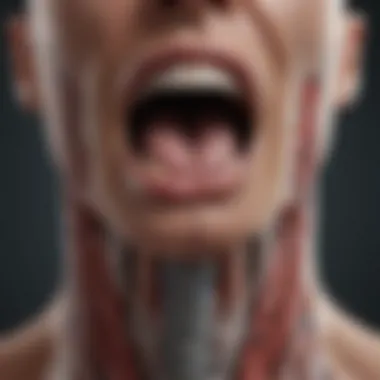Understanding Weak Throat Muscles: Symptoms and Implications


Intro
Weak throat muscles can cause a variety of clinical issues that impact daily living. Understanding symptoms associated with this condition is essential for maintaining overall health. It is crucial to recognize the signs early, given that they can affect speech, swallowing, and respiratory function.
We will explore the anatomy of the throat to support our understanding of how weakness manifests. By identifying common symptoms, individuals can seek timely intervention. Additionally, underlying causes will be discussed, shedding light on the significance of this condition in clinical practice.
Research Highlights
Key Findings
Research reveals that weak throat muscles often go unnoticed until a person experiences notable difficulties. Some key findings include:
- Swallowing difficulties: Weakness can lead to aspiration or choking, significantly increasing the risk of respiratory infections.
- Speech impairments: Voice quality may degrade, resulting in unclear speech and decreased communication effectiveness.
- Fatigue and discomfort: Patients may report general throat discomfort and excessive fatigue during speaking or eating.
The implications are impactful and often pervasive, highlighting the necessity for healthcare professionals to be vigilant.
Implications and Applications
The understanding of weak throat muscles can guide clinicians in several ways:
- Therapeutic approaches: Customized physical therapy regimens can strengthen the communciative functions of the throat.
- Early intervention: Prompt identification of symptoms allows for better management strategies, reducing complications.
- Patient education: Educating individuals about this condition can lead to self-monitoring and awareness of warning signs.
"Recognizing the symptoms of weak throat muscles can lead to timely interventions and improved quality of life for patients."
Methodology Overview
Research Design
A systematic review was conducted on existing literature related to weak throat muscles. This method allowed for the collation of diverse studies outlining symptoms and impacts, forming a strong foundation for our understanding of the issue.
Experimental Procedures
Studies included analyzing patient records and interviews to gather firsthand accounts of symptoms. Additionally, clinical assessments were examined to identify physiological deficits in patients with impaired throat function. This approach provides reliable insights into everyday experiences of those affected.
By solidifying a comprehensive understanding of weak throat muscles, we aim to foster awareness and ultimately improve clinical practices for better patient outcomes.
For further information, consider visiting Wikipedia or Britannica.
There are numerous resources to assist both patients and healthcare professionals in understanding this condition better.
Preface to Weak Throat Muscles
Weak throat muscles represent a fundamental issue that can significantly affect several vital functions, including speech and swallowing. This section aims to highlight the relevance and importance of recognizing this condition. Moreover, weak throat muscles can lead to various complications that alter daily living and overall health outcomes.
Understanding weak throat muscles involves examining the anatomical and physiological aspects of the throat. It is essential to comprehend how different muscles in the throat work together to facilitate communication and nutrient intake. These muscles play a crucial role in fundamental activities, and their dysfunction can lead to detrimental effects.
Awareness of weak throat muscles is essential for early diagnosis and intervention. Individuals experiencing symptoms related to throat weakness may not immediately recognize them as issues linked to muscle strength. Therefore, educating both the general public and medical professionals about this condition is vital. Such awareness can promote timely medical evaluation and suitable therapeutic options.
Some specific elements to consider include the fact that weak throat muscles can affect speech clarity, making communication difficult. This condition can also lead to swallowing difficulties, increasing the risk of aspiration and subsequent health problems. By recognizing the symptoms of weak throat muscles, individuals can seek appropriate care and potentially prevent severe complications.
In summary, addressing the weak throat muscles in this article becomes significant for multiple reasons. It increases understanding, promotes awareness, and aids in fostering timely interventions. The discussion revolves around understanding symptoms, causes, diagnostic approaches, and treatment options, all of which are critical for managing this condition effectively.
Anatomy of the Throat Muscles
Understanding the anatomy of the throat muscles is crucial for comprehending the implications of weakened muscle strength in this area. The throat comprises several muscle groups that play distinct roles in various bodily functions. The coordination of these muscle groups is essential for speech, swallowing, and ensuring a clear airway. Recognizing the specific functions of these muscles helps in identifying symptoms associated with weakness and understanding the overall health impact.
Pharyngeal Muscles
The pharyngeal muscles form a critical component of the throat's anatomy. They are responsible for facilitating the swallowing process by constricting and relaxing to push food from the mouth down into the esophagus. These muscles are categorized into three main groups: the superior, middle, and inferior constrictors. Weakness in these muscles can lead to difficulty in swallowing, a condition known as dysphagia. This not only affects nutrition but can also cause a fear of eating, significantly impacting quality of life. The pharyngeal muscles also contribute to the production of certain sounds, linking their functionality to both nourishment and communication.
Laryngeal Muscles


Laryngeal muscles, which include both intrinsic and extrinsic groups, are vital for voice production and protecting the airway during swallowing. The intrinsic muscles adjust the tension of the vocal cords, allowing for a range of sounds and pitches. Weak laryngeal muscles can lead to hoarseness or difficulty in producing clear vocal sounds, possibly affecting social interactions and self-expression. Additionally, these muscles help in closing the airway to prevent aspiration, illustrating their dual role in both communication and safety during eating.
Esophageal Muscles
The esophageal muscles are essential for transporting food from the throat to the stomach. These muscles consist of both voluntary and involuntary components that facilitate peristalsis, a wave-like movement that propels food downward. Weakness in the esophageal muscles may present with gastroesophageal reflux symptoms, causing discomfort and potential damage to the esophagus. It is important to understand that compromised esophageal muscle function can lead to additional complications, emphasizing the need for early detection and appropriate intervention to manage symptoms effectively.
Understanding these muscle groups and their roles reveals the intricate connection between anatomy and everyday functions such as eating, speaking, and breathing. By recognizing the anatomy of the throat muscles, one can better appreciate the importance of muscle strength and function in maintaining overall well-being.
Identifying Symptoms of Weak Throat Muscles
Recognizing the symptoms associated with weak throat muscles is essential for effective management of the condition. Early identification can lead to proper interventions, which can significantly improve the quality of life for individuals affected. Understanding these symptoms not only aids patients in seeking help but also equips healthcare professionals with the necessary knowledge to initiate appropriate assessment and treatment.
Speech Difficulties
One common symptom of weak throat muscles is speech difficulties. Patients might notice changes in their ability to articulate words clearly. This can manifest as slurred speech or difficulty in pronouncing certain sounds. These changes can lead to frustration in social interactions and may impact self-esteem. Speech therapy can often help, targeting the specific articulatory challenges that arise due to muscle weakness. Identifying speech difficulties early is crucial in tailoring effective interventions.
Swallowing Issues
Swallowing issues are another visible symptom of weak throat muscles. Individuals may experience dysphagia, a condition characterized by difficulty swallowing. This can be evident with feelings of food getting stuck in the throat or discomfort while swallowing. Such symptoms can lead not only to physical health problems but also emotional distress. It is important for healthcare providers to assess such issues promptly. Patients may benefit from swallowing techniques or therapy aimed at strengthening the muscles involved.
Choking Sensations
Choking sensations can often be alarming for individuals with weak throat muscles. These sensations may occur during eating or drinking. This can cause significant anxiety and negative associations with mealtime, further complicating dietary habits. It is vital to explore these sensations alongside other symptoms to determine if they are directly related to muscle weakness or other conditions.
Voice Changes
Weak throat muscles can significantly alter one’s voice. Changes might include hoarseness or a breathy quality to speech. These alterations can stem from improper function of the laryngeal muscles, which are pivotal for voice production. Patience is necessary, as vocal training and therapy play crucial roles in restoring voice quality. Identifying these changes early can help establish a therapeutic relationship and a path to recovery.
Gastroesophageal Reflux Symptoms
Gastroesophageal reflux symptoms can also relate to weak throat muscles. Symptoms such as heartburn or regurgitation can occur when the throat muscles are unable to adequately perform their functions. This can lead to irritation and inflammation of the throat, complicating overall health. Early diagnosis and management of these symptoms can help mitigate their impact, ensuring better health outcomes for the individual.
Proper assessment of throat muscle function is critical for preventing further complications related to these symptoms, including aspiration pneumonia and nutritional deficits.
Causes of Weak Throat Muscles
Understanding the causes of weak throat muscles is essential for unraveling the broader implications this condition has on an individual’s health. Weakness in these muscles can lead to significant challenges in swallowing, speaking, and overall quality of life. Identifying the underlying factors can guide appropriate interventions and management strategies, benefiting both patients and healthcare providers. Factors contributing to this condition can be categorized into various medical and lifestyle origins.
Neurological Disorders
Neurological disorders play a crucial role in the development of weak throat muscles. Conditions such as amyotrophic lateral sclerosis (ALS), multiple sclerosis (MS), and Parkinson’s disease can impair the nerve signals that control muscle function. This impairment leads to decreased muscle strength and coordination. Weakness in the throat muscles can occur as the disease progresses, resulting in more severe complications like dysphagia and aspiration.
Muscular Dystrophies
Muscular dystrophies are a group of genetic disorders characterized by progressive muscle weakness. Conditions like Duchenne muscular dystrophy or myotonic dystrophy affect not only the skeletal muscles but can also compromise throat muscle function. This weakening can escalate over time, making swallowing and speaking increasingly difficult. Early diagnosis and management can help mitigate some of the challenges associated with these disorders, though they require ongoing care and support.
Aging Process
The aging process inherently affects muscle strength, including the throat muscles. As individuals age, the natural atrophy of muscle fibers occurs, leading to reduced muscle mass and function. Conditions such as sarcopenia, which denotes age-related muscle loss, can negatively affect swallowing and speaking abilities. Moreover, older adults often experience additional complications, such as other comorbidities, that can exacerbate the impact of weak throat muscles.
Impact of Alcohol and Tobacco Use
Alcohol and tobacco use is another influential factor in the strength of throat muscles. Chronic alcohol consumption can lead to neurological disorders and weaken muscle response due to its toxic effects on nerve and muscle tissues. Likewise, smoking tobacco introduces harmful chemicals into the body, leading to inflammation and potential damage to throat structures. These habits can reduce the effectiveness of throat muscles, increasing the risk for various complications related to speech and swallowing.
"Addressing the causes of weak throat muscles is not just about immediate effects; it is about understanding the journey of the individual and implementing better management strategies."
By recognizing these causes, healthcare professionals can provide targeted recommendations and therapies to help improve muscle strength and functionality. Awareness of these factors is necessary for proper diagnosis and treatment planning.
Diagnostic Approaches
In the exploration of weak throat muscles, diagnostic approaches play a crucial role in identifying the underlying issues and determining proper treatment strategies. This section discusses several fundamental elements of diagnosis, emphasizing the importance of recognizing weakness in throat muscles as early as possible. Accurate assessment not only aids in diagnosing the condition but also assists clinicians in differentiating among various causes that contribute to muscle weakness.


Clinical Assessment
A detailed clinical assessment is often the first step in diagnosing weak throat muscles. This process includes taking a comprehensive patient history and conducting a physical examination. Clinicians inquire about the patient’s symptoms, their duration, and severity. They also assess voice quality, swallowing ability, and any associated discomfort. Clinical assessment may involve looking for specific reflex actions, which can reveal important functional deficits in the throat muscles.
A thorough clinical assessment is crucial in understanding the specific challenges faced by a patient, ultimately guiding the course of treatment.
Imaging Techniques
Imaging techniques can serve as an important adjunct in the diagnostic process. Methods such as magnetic resonance imaging (MRI) or computed tomography (CT) scans can provide detailed views of the throat anatomy. These images may help detect structural abnormalities or other conditions affecting muscle strength. Especially in cases where neurological components are suspected, imaging can highlight communication pathways in the brain that may influence throat muscle functioning.
Additionally, videofluoroscopy is a dynamic imaging technique used to visualize swallowing. This approach provides real-time feedback on how food is manipulated within the throat. Such valuable insights contribute significantly to understanding the extent of muscle weakness and guiding further interventions.
Functional Tests
Functional tests assess throat and swallowing capabilities, offering direct insight into muscle strength and coordination. One common approach is the Fiberoptic Endoscopic Evaluation of Swallowing (FEES), which uses a tiny camera to observe the swallowing process in real time. This test allows professionals to see how well the muscles are contracting and relaxing during swallowing.
Swallowing assessments can also be carried out through various standardized tests, which measure the amount of food a patient can swallow without difficulties. These functional evaluations help shape an understanding of the severity of weakness in throat muscles and facilitate appropriate recommendations for therapeutic options.
Therapeutic Options
The management of weak throat muscles is essential for improving patients' quality of life. Effective therapeutic options can help restore function, alleviate discomfort, and prevent complications. It is vital to customize these approaches according to individual needs. Patients may experience different symptoms and limitations, so options should suit unique circumstances for best results. Here are the primary therapeutic avenues:
Speech Therapy
Speech therapy plays a crucial role in addressing weak throat muscles. It aims to improve articulation and enhance vocal quality. Through exercises and techniques, patients can learn to strengthen their muscles and gain better control over speech production. Speech therapists often employ specific strategies tailored to the unique challenges faced by individuals.
In general, sessions may include:
- Breathing exercises to improve airflow.
- Vocal exercises to strengthen the voice.
- Resonance therapy to enhance sound quality.
Regular engagement in speech therapy can lead to significant improvements. Over time, many witness increased confidence in their communication abilities.
Swallowing Therapy
Swallowing therapy focuses on correcting swallowing difficulties caused by weakness in throat muscles. A specialist works with patients to assess swallowing patterns and identify areas for improvement. This therapy is critical because swallowing issues can lead to serious health risks, like aspiration.
Some techniques may involve:
- Exercises aimed to strengthen muscles involved in swallowing.
- Diet modifications to introduce safer food textures.
- Posture adjustments during eating to reduce choking risk.
Patients often report feeling more secure while eating and drinking after participating in swallowing therapy. This intervention can significantly enhance the overall enjoyment of meals.
Medications
While there is no specific medication for weak throat muscles, treating underlying conditions can improve symptoms. For instance, medications might be prescribed to manage related issues like inflammation or other contributing disorders. Discussing options with a healthcare professional is crucial for determining if this is a suitable course of action.
Some commonly considered medications may include:
- Anti-inflammatories to reduce swelling.
- Neuromuscular agents in specific cases.
- Proton pump inhibitors for those with gastroesophageal reflux symptoms.
Exploring medication alongside other therapies can create a more comprehensive treatment plan.
Surgical Interventions
In severe cases, surgical interventions may be necessary. These can help rectify structural problems affecting throat muscle function. When nonsurgical options do not yield adequate results, surgery is considered. It is essential that patients engage in thorough discussions with their doctors regarding the risks and benefits.
Potential surgical options could involve:
- Neuromuscular surgery to improve muscle control.
- Reconstruction surgery for anatomical issues affecting function.
- Implants or stimulators designed to assist with swallowing and speech.
While surgery presents a more permanent solution, thorough evaluation and consideration of all options is critical for ensuring patient safety and satisfaction.


Understanding these therapeutic options is vital for individuals facing challenges with weak throat muscles. Early intervention and tailored treatment plans can foster meaningful improvements.
Potential Complications
In the context of weak throat muscles, recognizing potential complications is crucial. These complications can significantly affect a person's quality of life and health outcomes. Understanding the various issues that may arise helps in fostering awareness and urgency for medical intervention. By identifying these complications early, effective management strategies can be implemented, preserving both physical health and psychosocial well-being.
Aspiration Pneumonia
Aspiration pneumonia is one of the most serious risks associated with weak throat muscles. When swallowing is compromised, food or liquids may enter the airway instead of proceeding down the esophagus. This misdirection can lead to inflammation and infection in the lungs. Symptoms often include coughing, difficulty breathing, and fever.
Preventive measures are essential. For individuals experiencing weak throat muscles, recognizing the signs of swallowing difficulties is important. Feeding methods can be adjusted to incorporate thicker liquids or softer foods. This could minimize the risk of aspiration. Regular consultation with healthcare professionals, such as speech-language pathologists, can also aid in developing safer swallowing techniques.
"The risk of aspiration pneumonia necessitates close monitoring and proactive strategies, making early recognition of swallowing issues vital for patient safety."
Nutritional Deficits
Weak throat muscles can severely impact a person’s ability to eat properly. When swallowing becomes difficult, individuals may avoid certain foods or stop eating altogether. This avoidance can lead to nutritional deficits, resulting in weight loss and malnutrition. Malnutrition can further complicate existing health issues and modify the body's ability to recover from illnesses.
Healthcare providers should assess the dietary habits and nutritional status of those with weak throat muscles. Encouraging small, frequent meals or the incorporation of nutritional supplements can be beneficial. Moreover, working with a registered dietitian can provide tailored dietary plans that meet the individual's specific needs and preferences.
Psychosocial Impact
The implications of weak throat muscles extend beyond physical health. The psychosocial impact can manifest as anxiety, depression, and social isolation. Individuals may feel embarrassed about their condition and avoid social gatherings, particularly those involving meals. Fear of choking or experiencing discomfort can lead to significant changes in lifestyle and personal interactions.
Support groups or therapy can help address the emotional toll. Engaging with others who face similar challenges provides a sense of community and understanding. Encouraging open communication with family and friends can also alleviate feelings of isolation. It's critical that both patients and their support systems understand the importance of addressing the psychological aspects of living with weak throat muscles.
These complications underscore the need for an integrated approach to treatment that encompasses not only physical health but also mental and social well-being.
Preventive Strategies
Preventive strategies play a crucial role in managing the health of throat muscles. By focusing on practical modifications and proactive health assessments, individuals can take steps to mitigate the risks associated with weak throat muscles. Such measures can lead to better overall health, enhance one’s quality of life, and prevent complications down the line. Understanding how to implement these strategies is vital for those at risk or experiencing symptoms.
Lifestyle Modifications
Engaging in lifestyle modifications can significantly impact throat health. These changes are often simple yet effective. Some key areas to focus on include:
- Hydration: Staying well-hydrated helps to keep throat muscles lubricated, promoting better function.
- Dietary Adjustments: Incorporating soft foods and avoiding overly hot or spicy items can ease the strain on throat muscles during swallowing.
- Smoking Cessation: Quitting smoking benefits not only the throat muscles but overall respiratory health as well.
- Limit Alcohol Consumption: Excessive alcohol intake can lead to inflammation and other complications, impacting swallowing and speech.
- Vocal Care: Proper vocal hygiene, including warm-ups before extensive speaking, can help reduce strain on the laryngeal muscles.
Incorporating these changes into daily routines is important. Each modification contributes to the endurance of throat muscles and decreases the risk of further weakness.
Regular Screenings
Regular screenings are essential for early detection and intervention regarding weak throat muscles. These assessments allow healthcare providers to monitor the condition, identify potential issues, and tailor therapeutic strategies based on individual needs. The following screening practices can be beneficial:
- Professional Evaluations: Consulting with an otolaryngologist or speech-language pathologist can provide insights into muscle function and performance.
- Swallowing Tests: These tests, which include videofluoroscopy, can identify swallowing difficulties and guide appropriate interventions.
- Voice Assessments: Regular voice checks can help detect changes in vocal quality, leading to timely management.
- Neurological Assessments: Given that some causes of weakness might be neurological, evaluations focused on nervous system health could provide critical insights.
Regular screening encourages early diagnosis, which can prevent complications associated with weak throat muscles. They also enable personalized care, adjusting preventive measures as needed.
"Early identification of throat issues can lead to better outcomes and preserve overall throat health."
Implementing these preventive strategies fosters a proactive approach to health. As a result, they can significantly lessen the burden of weak throat muscles on daily living.
End
The conclusion of this article serves as a critical reflection on the importance of understanding weak throat muscles and their significant implications for health. Weak throat muscles can severely affect essential bodily functions such as speech and swallowing. Recognizing the symptoms is vital for timely intervention, which can greatly improve quality of life.
Medical practitioners, students, and researchers must keep in mind the array of symptoms associated with this condition. Symptoms can range from minor speech issues to serious swallowing complications, impacting not just individuals but also their families and caregivers. The clinical implications are profound, necessitating a proactive approach to diagnosis and treatment.
Key Points to Consider
- Early Recognition: Identifying symptoms soon may prevent unnecessary complications.
- Multidisciplinary Intervention: Various healthcare professionals play a role in treatment, from speech therapists to surgeons.
- Long-term Implications: Failure to address weak throat muscles can lead to conditions like aspiration pneumonia or nutritional deficiencies.
Understanding these aspects opens pathways for preventive strategies. Lifestyle modifications and regular screenings can help mitigate risks associated with weak throat muscles. The dialogue surrounding this condition needs to include more public awareness and education initiatives to empower individuals.
In summary, the condition of weak throat muscles is both complex and significant. It demands attention not only from healthcare providers but also from the wider community. Continuous research and understanding will facilitate better therapeutic options and, ultimately, enhance patient outcomes.
"The strength of the throat muscles is paramount not just for communication but for fundamental survival functions like eating and drinking."
By remaining informed and proactive, individuals can better navigate the challenges presented by weak throat muscles.



